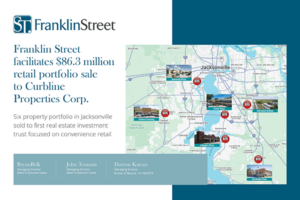A leasing agent’s perspective can improve a retail property’s salability.
When an owner considers the sale of a retail property, the process begins not the day a listing goes online but two or even three years beforehand. A smart owner will assemble a team to develop and execute a plan to prepare and market the property.
Exit Strategy
In addition to the owner, the leasing agent and property manager are critical to achieve the owner’s goals for a property. An experienced leasing agent can bring important information to the table, including local market vacancy rates, competition, tenant prospects, and leasing trends.
Leasing is an essential element of selling the property because potential buyers look at more than just base rent and net operating income. Minimizing restrictive and adverse lease provisions in new leases and eliminating them from existing tenant leases should be a key component in the overall leasing strategy. The leasing agent can improve results by weighing in on the following factors.
Determine tenant mix. Tenants set the tone for shopping centers, so consider if the existing business support each other. For example, business or medical offices may not be a good fit for a grocery-anchored shopping center. The solution could be to relocate them to a better position for their use in the center or replace them with tenants that improve the overall tenant mix.
Problem tenants, such as poor operators, outdated concepts, or those with collection issues, may need to be eased out of the property. That’s doable in a two- to three-year period. Identifying and incorporating these spaces into the overall leasing strategy can open up additional leasing opportunities that may not be available with just the existing vacancies. Larger spaces can be created or end-cap opportunities may be available, expanding the list of potential tenants that can be targeted.
Attract best-in-class tenants. Reputation, creditworthiness, and the kinds of customers the tenant attracts should all be considered, for both the larger national and regional tenants as well as small-shop and local tenants. Understanding these targeted tenants’ needs and lease structures is essential to determine how to attract them to a center and away from your competition. Depending on the landlord’s flexibility, lease terms can be more generous in terms of rent, tenant improvements, signage, location in the center, and renewal and extension options.
Integrate leasing into the sales strategy. Lease extensions for the best tenants add tremendous value to a sale. When approaching tenants, a smart leasing agent starts with questions: Is the space the right size? Is it in the right location? What capital improvements are needed? Do they plan to update the store? The answers will tell the owner whether to invest in an early lease renewal as well as identify tenants that may have plans to leave or close, allowing the leasing agent to actively pursue replacement tenants before the existing leases expire.
Establish realistic market rates and lease structures. The leasing agent studies the market to establish realistic market rates, but the toughest part is figuring out how much to spend on build-out. Tenant improvement dollars will vary greatly depending on the tenant. Regional or national tenants will have specific needs, requiring either a “modified white box,” substantial TI allowance, or a combination of the two.
An experienced leasing agent will evaluate local tenants to determine their viability and whether a landlord should invest in them. Alternatively, incentives such as free rent, reduced rent, or lower initial base rates will annual escalations that grow the rate back to the market rates over a few years can help local retailers to succeed in the center. A leasing agent can attract new tenants or negotiate lease extensions by offering TI money, but a smart agent will use that carrot carefully because experienced buyers recognize when a landlord is buying up the rate. The leasing agent can also help reduce the number of lease red flags that a prospective buyer will discover during due diligence, such as co-tenancy requirements, kick-out provisions, and exclusives or restricted uses.
Determine what improvements and deferred maintenance are needed. The leasing agent’s unique perspective can help inform decisions on investing dollars to reduce vacancy and improve the tenant mix in a way that raises the market value of the property. Such insights include:
- evaluating and advising if existing vacant spaces should be returned to a whitebox condition, removing previous tenant finishes;
- demising larger spaces or combining smaller spaces to meet market needs;
- improving viability and access;
- determining if additional or improve signage is needed;
- updating overall exterior appearance through renovation; and
- improving landscaping and site lighting.
Savvy owners bring trusted and knowledgeable leasing agents into conversations when the decision is made to sell the property. The ultimate goal of the leasing agent is to produce the best return on investment, whether that comes from re-doing the facade to attract better tenants or renegotiating a lease so that a quality occupant is secured for a number of years. The leasing agent best understands how terms, rates, and property improvements affect the sales price.
Jamie Swanson is a director of Franklin Street, a full-service commercial real estate firm in the Southeast. Contact him at [email protected]. Download PDF



